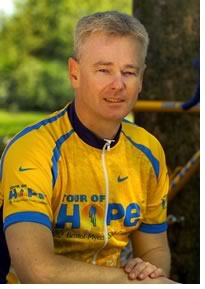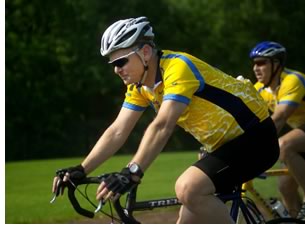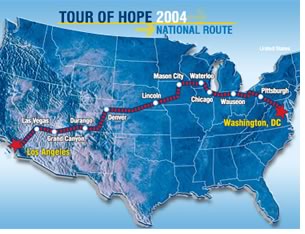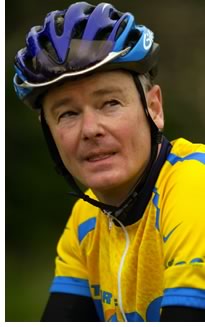

Cycles of Hope: Architect Rides with Lance Armstrong to Promote Cancer Research

by Tracy Ostroff
Thanks, he says, to drugs he received through clinical trials, leukemia survivor Michael Siegel, AIA, had the endurance twice to send his cancer into remission. This fall, he is again testing his stamina by cycling 3,500 miles cross-country to promote the importance and expansion of clinical trials and cancer research, goals near and dear to his and his family’s heart. The VOA Associates senior vice president is among the 20 riders selected from nearly 1,200 applicants to make the journey from Los Angeles to Washington, D.C., with six-time Tour de France winner Lance Armstrong, in the Bristol-Myers Squibb Tour of Hope.
 The
tour kicks off in Los Angeles October 1 and will be joined by Armstrong
at points along the way before arriving in the nation’s capital
on October 9. The team will relay ride in four- to five-hour segments
per day; the public will have the opportunity to show riders their support
along the route. The team is in 16 weeks of Web-based training with Armstrong’s
personal coach.
The
tour kicks off in Los Angeles October 1 and will be joined by Armstrong
at points along the way before arriving in the nation’s capital
on October 9. The team will relay ride in four- to five-hour segments
per day; the public will have the opportunity to show riders their support
along the route. The team is in 16 weeks of Web-based training with Armstrong’s
personal coach.
Supporting clinical
trials
Siegel’s positive experiences with clinical trials motivate his
efforts. When he was first diagnosed, Siegel was married with three children;
his wife was pregnant with twins. Doctors prescribed a bone marrow transplant
that had a 50-50 chance of survival, a “terrifying” prospect
he says. Instead, he decided to search for alternatives, entering a clinical
trial at M.D. Anderson Cancer Center in Houston where doctors were having
success with the chemotherapy drug Interferon. His leukemia went into
remission. “The side effects were horrendous, but it kept me alive,”
Siegel says.
But after about four and a half years the drug stopped working, and the cancer returned at “full bore.” Siegel says his doctor placed him as the first patient in a Phase II trial for Gleevec, a new drug that, to Siegel’s delight, had no side effects. Three months later, his leukemia was again in remission, and four years later he is still cancer free. Siegel is still in the clinical trial and continues to take the study drug, which has since been approved by the Food and Drug Administration.
“I owe my life to cancer research,” Siegel says. “My personal experience has convinced me that research creates new drugs and treatments that save lives and improve the quality of life.” His enthusiasm and treatment success has prompted two of his family members diagnosed with cancer to seek out clinical trials. For many patients, Siegel says, clinical trials are a “safe treatment option that might be the way to go. Every cancer drug we have today went from the research lab to the clinic to be used for patients through this process of clinical trials. If we don’t increase participation in clinical trials, we won’t bring these new drugs to the world.” The drugs, he says, go from a research lab to the patient through a thorough process. “You’re not a science experiment or guinea pig.”
 “If
you have to deal with cancer yourself or a friend or a family member does,
knowledge is power. Get in there and ask your caregiver questions, and
questions, and questions, and understand your options. Ask if there’s
a clinical trial that’s appropriate for what you’re fighting,”
Siegel advises.
“If
you have to deal with cancer yourself or a friend or a family member does,
knowledge is power. Get in there and ask your caregiver questions, and
questions, and questions, and understand your options. Ask if there’s
a clinical trial that’s appropriate for what you’re fighting,”
Siegel advises.
From fear to excitement
Siegel says he is grateful that he’s had the support of his employers
from both Booth Hansen Architects when he was first diagnosed and now
from his colleagues at VOA. He says he’s maintained his workload
while spending a little more time going to the doctor. He’s also
thankful for the Blue Cross/Blue Shield PPO health insurance that has
covered his treatments through the two clinical trials.
Before his cancer treatments took a toll on his body Siegel was a triathlete, competing in Iron Man races. Once running became too difficult on his body, he turned his efforts toward his biking. “It got me out in the morning. It was kind of an act of defiance. I’d ride the lakefront in Chicago every day to work. It let me convince myself that I wasn’t going to go today.”
 Siegel
says he’s keeping a journal to chronicle this interesting journey
and to record his emotions about the ups and downs of training. “When
you apply to the Tour of Hope program you have an understanding of how
you might fit in, how you might align with the project’s goals,
and you have some idea that you might be able to do this physically—you’re
an athlete, you’ve ridden enough, and you can get through this”
Siegel says. But it still took him some time come to grips with “why
I belong with this incredible group of people,” which includes “doctors
who have helped create the drug that keeps you alive to people who have
been through two or three stem cell transplants and recurrences before
going on a clinical trial and become healthy again, to husbands who have
lost their wives, to a father who’s little child was dealing with
leukemia, to a mother who lost her son who has the strength to stand there
and say ‘my son chose me to carry this message forward.’”
Siegel
says he’s keeping a journal to chronicle this interesting journey
and to record his emotions about the ups and downs of training. “When
you apply to the Tour of Hope program you have an understanding of how
you might fit in, how you might align with the project’s goals,
and you have some idea that you might be able to do this physically—you’re
an athlete, you’ve ridden enough, and you can get through this”
Siegel says. But it still took him some time come to grips with “why
I belong with this incredible group of people,” which includes “doctors
who have helped create the drug that keeps you alive to people who have
been through two or three stem cell transplants and recurrences before
going on a clinical trial and become healthy again, to husbands who have
lost their wives, to a father who’s little child was dealing with
leukemia, to a mother who lost her son who has the strength to stand there
and say ‘my son chose me to carry this message forward.’”
 A
most important journey
A
most important journey
As he has prepared for the tour, first riding 10–12 hours per week,
and now 14–16 hours divided among early morning and long weekend
rides with his dedicated family, his emotions have turned from fear to
excitement. “When you make the first cut from 1,200 applicants to
50 it’s overwhelming.” When Siegel got the final call he says
he was “floating around for days.”
“My family has lived through the ‘we have to help dad survive cancer thing.’ They know how important this journey is and this message is and they’re tremendously supportive of it. It’s in a way something that I definitely owe to the cancer community to go out and support this fight now, and my family does as well. So my wife does a lot of training rides, and my older boys do a lot of training rides with us. And the little ones are always delighted to get an extra hour of cartoon watching in the morning, so they don’t seem to be bothered very much either.”
He urges people to get involved in their own way. “Go to the Web site, and make that cancer promise,” which expands the commitment from 20 riders to a much larger group of cyclists across the country. “It’s a very exciting thing. It’s a lot of work, not an easy thing. Physically it’s challenging, mentally it’s been challenging, but every bit of it is worth it. It’s an important cause.”
Copyright 2004 The American Institute of Architects.
All rights reserved. Home Page ![]()
![]()
 |
||
| Make a
donation or get
in touch with Siegel through his Tour of Hope Web page. Photos courtesy of Tour of Hope. More detail, including a tentative schedule and city stops, will be available later so people across the country can track the team’s progress and show their support. Check here during the week of the tour for daily updates.
|
||